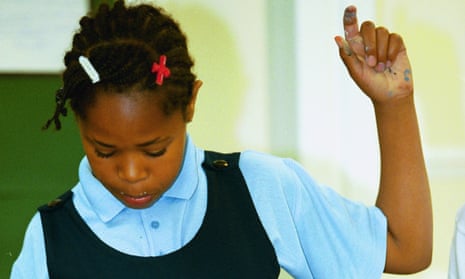A few weeks ago, a six-year-old black girl named TT was suspended and sent home because she poked a boy with an eraser.
When I asked her what happened, TT told me that the boy was bothering her and wouldn’t stop even after she asked him, so she poked him with an eraser. TT was subsequently suspended from school for two days.
As a mother of a kindergartener, I am very familiar with this type of age-appropriate childish misbehavior. As an organizer for Power U Center for Social Change, a grassroots organization based in Miami, the fact that another student of color was harshly and unfairly punished for age-appropriate behavior also did not surprise me. TT was just one of many girls who fall victim to zero-tolerance and school push-out every day.
As most education advocates know, zero-tolerance policies shut the doors of academic opportunity to students of color by funneling them into the juvenile and criminal justice systems. The combination of overly harsh school policies and the growing role of law enforcement in schools has created a school-to-prison pipeline, in which punitive measures such as suspensions, expulsions and school-based arrests are increasingly used to deal with student misbehavior. What many education advocates aren’t talking about, however, are the gender dynamics at play in this phenomenon.
A recent report by the African American Policy Forum (AAPF) entitled Black Girls Matter: Pushed Out, Overpoliced and Underprotected, outlines how girls of color face much harsher school discipline than their white peers but are simultaneously excluded from current efforts to address the school-to-prison pipeline. The report states that nationally, black girls are six times more likely to get suspended than their white counterparts. In comparison, black boys are three times more likely to get suspended than their white counterparts.
Despite the statistics, there are no initiatives like the My Brother’s Keeper program – a five-year, $200m program initiated by President Obama to support boys of color – to engage and nurture young women of color. Even though black girls are criminalized and brutalized by the same oppressive system, rarely does their brutalization make national news.
Consider the case last year of 17-year-old high school student Brittany Overstreet in Tampa Bay, Florida. According to local news reports, she was “accused of becoming combative and aggressive toward school administrators” when they wanted to search her bag for mace. During a struggle with the officer the teenager was slammed twice on the ground, which resulted in a concussion and her jaw being fractured in two places. She was handcuffed, suspended for 10 days and faced criminal charges. She did not have mace in her purse.
In the current movement to dismantle the school-to-prison pipeline, girls like Brittany are often an afterthought. As a black woman, I experience the intersection of race and gender every day: I see the ways in which black girls are subjugated simultaneously by patriarchy, white supremacy and heterosexism. Worse yet, we are also expected to be strong and indestructible, an attribute that is also detrimental because black girls are perceived as being more socially mature and self-reliant and thus also receive less attention in school.
In my work, I have often found that when black girls struggle with trauma and other unmet needs, they only receive attention from school staff when their behavior leads to punishable offenses, particularly in school districts like Miami that rely on harsh discipline and zero-tolerance. Despite gendered vulnerabilities like sexual victimization, pregnancy and significant familial responsibilities that many black girls experience, they are socialized to hold in their pain and their trauma.
When girls cry for help, both explicitly and implicitly through misbehavior, school officials should immediately engage them. This is a great opportunity to build relationships with students, helping them see the harm that was caused and teaching them how to address their problems. This simple solution is known as restorative justice, a non-punitive way of addressing conflict and building relationships that shifts the culture of our schools and hold not only students, but public officials and teachers accountable.
In addition to restorative justice, the aforementioned AAPF report also outlines interventions to address the various challenges facing girls of color, including: developing programs that identify signs of sexual victimization; advancing programs that support girls who are pregnant, parenting or otherwise assuming significant familial responsibilities and improving data collection to better track discipline and achievement by race/ethnicity and gender for all groups.
Policymakers should take heed to these recommendations and commit to an approach to dismantling the pipeline that takes into account how race, gender and other forms of bias can intersect to exacerbate discrimination faced by individuals. As a mother of two black girls, I want schools to be a place where they can learn without the threat of being pushed out or excluded; where they can speak up without being silenced and where their needs, hopes and dreams are heard and valued.
